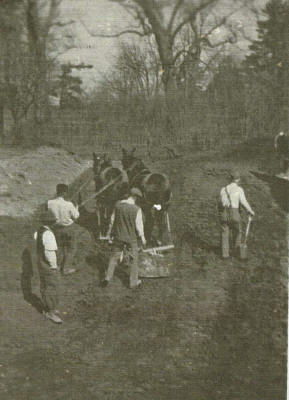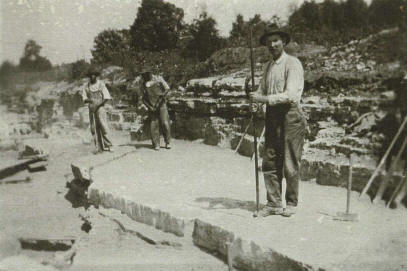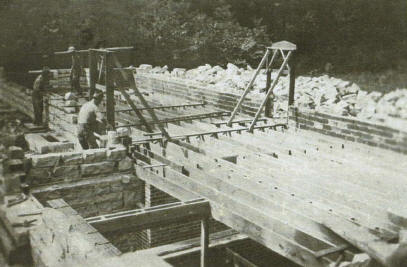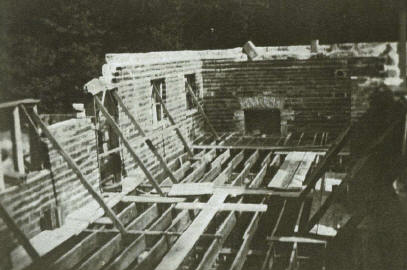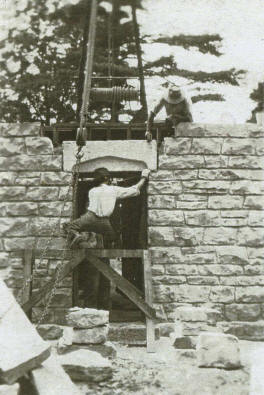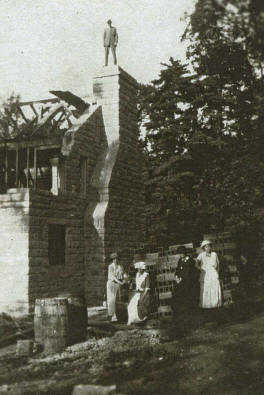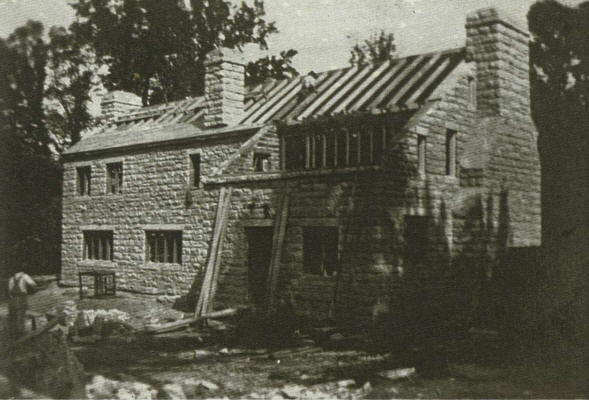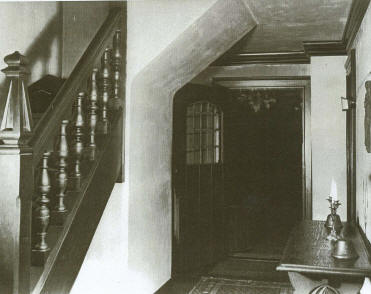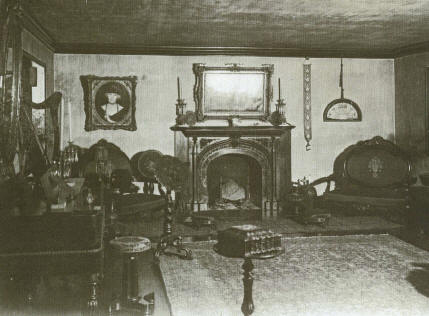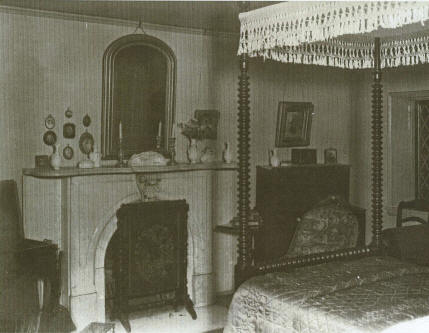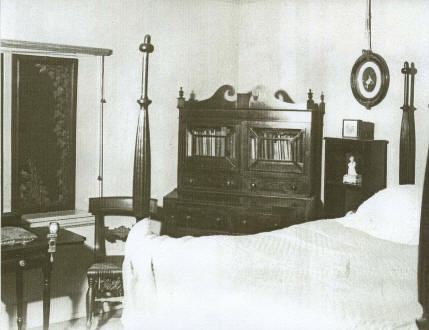“Twigmore”
Home of Kate Matthews’ Niece, Lillian “Muff” Fletcher Brackett
Once Visited by Nationally Known Critic and Radio Show Host,
Alexander Woollcott
The Construction Process

Twigmore’s front exterior when it was first completed in 1923.
It bears the unique distinction of being the only documented architect-designed home in Pewee Valley,
according to information submitted to the National Register of Historic Places.
Though Twigmore wasn’t constructed until 1923 — too late to be included in the “Little Colonel” stories – it quickly became a favorite Pewee Valley gathering spot. The charming Cotswold-style cottage was built by Lillian Fletcher, niece of Pewee Valley photographer Kate Matthews, 30 years before her marriage to award-winning screenwriter and film producer Charles Brackett. An Indianapolis native and daughter of Kate’s sister, Mary Matthews Fletcher, Lillian was 29 years old when she built the small, six-room home. Inspired by cottages she saw during a trip to England, she hired her cousin, Charles M. Osborn, an architect for Cram and Ferguson of Boston, Massachusetts, to design her new house in Pewee Valley.
Twigmore was built on land that was once part of the Edgewood estate next door. “35 Landmark Homes of Pewee Valley,” written by Anne H. Montgomery in 1994, recounts the negotiations between Edgewood’s owner, Fanny Craig, and Lillian Fletcher that were the genesis for the home’s unique name:
Dickering with Miss Fanny Craig for the property (Lillian Fletcher Brackett) now owns soon began. In fact, it was this humorous act of bargaining between the two women that gave the 121 Peace Lane residence its name. ..It was in the early 1920s when Miss Fanny Craig put a twig in the fence to determine just what amount of land she’d sell. Then Lillian put a twig in a different spot showing how much more she preferred. Even the neighbors got into the act and placed twigs at various locations. In the end Miss Fanny put a nail in a tree and said the house to be built could not stand in front of hers! And thus began Twigmore.
According to the National Register of Historic Places, the two-story home was built by local craftsmen using locally quarried limestone. Charlie Miller was the stone mason, while Alfonse Singer did the carpentry and millwork, including the specially crafted moldings and vertical door boards. Twigmore’s construction is well documented in photographs.
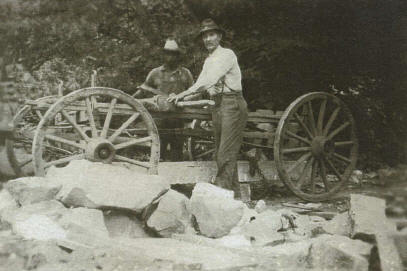
Moving the stone on a mule-drawn wagon
Twigmore: The People Who Lived and Visited There
Home of Kate Matthews’ Niece, Lillian “Muff” Fletcher Brackett
Once Visited by Nationally Known Critic and Radio Show Host,
Alexander Woollcott
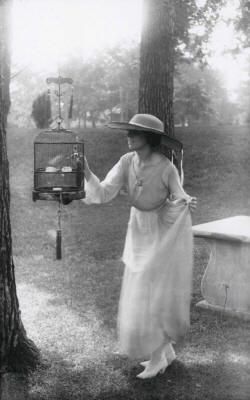
Twigmore’s owner, Lillian Fletcher Brackett, in a photo taken by her aunt Kate Matthews
from the Oldham County Historical Society collection.
For another photo of Lillian, visit the Kate Matthews page
After the home was finished, Lillian entered Twigmore in “The House Beautiful” magazine’s Small House Competition. Though it didn’t win, the letter and accompanying photos she submitted on December 16, 1924 provide many details about Twigmore’s interior and design.
Gentlemen –
The little house I am submitting with such genuine pride was built by two ladies who were weary of “going to and fro in the earth and walking up and down in it” and wished that they might have a house as beautiful, yet as simple, as that in which any poorest English peasant is privileged to pass his days.
Being unattached, we first sought out a perfect setting in a delightful Southern village, a small Cranford sort of place, and there where a winding road crosses a little lane buried in a burden of honeysuckle, we bought a small pine woods and built our house with workmen and stone of locality, paying for the one by the hour and the other by the perch.
It took us a year to build, which seems a long time for six rooms, but it is solid and without flaw and will I hope last many hundreds. Nothing that would make it permanent was omitted and as there are few servants to be had in the Valley, as in most pleasant places, we gave thought for the morrow when the cook cometh not, installed an electric stove and laid English linoleum in a black and rose chintz pattern in the kitchen for the edification of our souls.
But we have few frivolities, nothing was allowed that was not genuine, and that is a costly creed, so we pruned and expurgated, each holding to her most cherished point.
One had to have an attic and the other must have a sliding door to look off the stairs, then one need never be timid when alone. At last, however, our fifteen thousand dollars stretched itself into a house, worth much more than that as I am sure you would agree if you saw it from the garden by the back, or were having tea on its front terraces shaded by the soft green of the pines that hide us from the road. It is hard to believe that so much of dignity and comfort should be packed in so small and modest a home.
Very sincerely yours,
Lillian Fletcher
Pewee Valley, Ky.
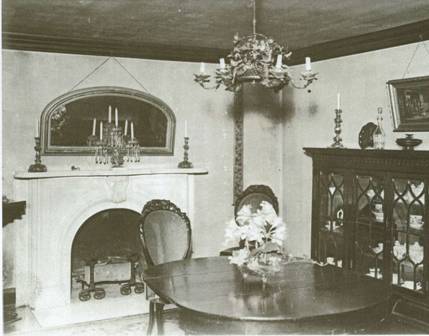
Lillian Fletcher Brackett once hung grapes dipped in sugar from the dining room chandelier
(shown above) for a party at Twigmore, according to Pewee Valley Historian Gin Chaudoin.
Known to her friends and family as Muff, Lillian Fletcher lived in Twigmore with her widowed aunt Charlotta Matthews Osborn until Charlotta’s death in 1935. Charlotta was one of Kate Matthews’ seven siblings and mother of architect Charles M. Osborn who designed the house. (Charles married Alice Malone, a Pewee Valley girl.) Charlotta is buried with her parents and many of her sisters and brothers in the Matthews family plot at Pewee Valley Cemetery
Prior to 1935, Alexander Woollcott — critic and commentator for “The “New Yorker,” magazine, host of the radio show “Woollcott Speaking,” and one of the most quoted men of his generation – paid a visit to Pewee Valley that ended with tea at Twigmore. An ardent fan of Kate Matthews’ photography, he wanted to meet the Matthews family in person and tour their home.
(From an address called “A Recollection of Kate Matthews, 1870-1975” given by Lillian Fletcher Brackett to the Oldham County Historical society on Friday, May 31, 1974 at the Brownsboro Social Club)
…Among her enthusiastic admirers was Alexander Woollcott. He came to Louisville at the time he was broadcasting his famous ‘Woollcott Speaking’ series on the radio from New York. Of course, the Matthews were listening to him being interviewed in Louisville. At the end of his interview he was asked what he most wanted to see while he was here. He surprised his interview and excited the Matthews by replaying, “I’d like to go to Pewee Valley and see the Matthews. I grew up in just such as house as Clovercroft and Kate Matthews’ pictures of that house and the Village streets and its characters are very dear to me. After that I want to see Twigmore and the farm bell named ‘Woollcott Speaking.’” George Madden Martin who wrote ‘Emmy Lou’ was to entertain Woollcott for luncheon, so Kate called her and asker her to bring him out in the afternoon. It was a fine autumn day, one of the Valley’s most beautiful and colorful. Mr. Woollcott insisted on seeing everything. He seemed very well acquainted with Kate Matthews’ pictures and begged to see the whole house, even the dark room and the grounds and scenes familiar through her pictures. He went though her albums and picked out the ones he knew and was fond of and afterwards wrote an enthusiastic letter of thanks and appreciation.
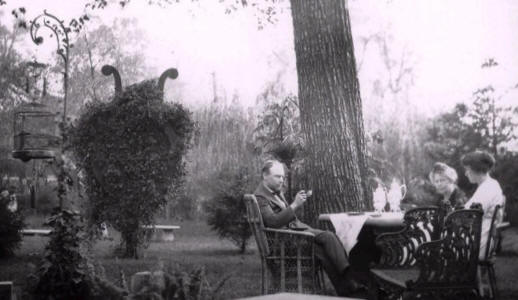
Tea in Twigmore’s backyard. The wooden lyre in the picture is still there today.
From the Kate Matthews Collection, Photographic Archives
Ekstrom Library, University of Louisville
On December 26, 1953, Lillian married her brother-in-law, Oscar-winning screenplay writer and producer Charles W. Brackett. Their marriage made the Monday, January 4, 1954 issue of “Time” magazine:
Married. Charles Brackett, 61, topflight Hollywood producer-director-writer (Lost Weekend, Sunset Boulevard); and Lillian Fletcher, fiftyish, his sister-in-law; he for the second time (his first wife, Elizabeth Fletcher Brackett, died in 1948), she for the first; in Tucson, Ariz.
Warder Harrison recounted the story of their marriage in the October 1998 issue of “The Kentucky Explorer:”
Famed Hollywood Writer, Charles Brackett, Had Ties To Kentucky
Noted Personality Wooed Second Wife in Pewee Valley, Kentucky
Charles Brackett, the writer/producer who won his first Oscar nomination in 1939, after teaming with Billy wilder and Walter Reisch to write the screenplay, “Ninotchka,” starring Greta Garbo, went on to team with Wilder to win their first Oscar, in 1945, after writing the best screenplay, “The Lost Weekend.” Five years later, the team of Brackett and Wilder collaborated with D. M Marshman, Jr., to write their second Oscar winning screenplay, “Sunset Boulevard.” Brackett and Wilder, after 15 years of successful collaboration, won their last Oscar, along with their other collaborator, Richard Breen, in 1952 for the best story and screenplay, “Titanic.” In 1957, Brackett was presented with a special Oscar for his outstanding service to the Academy of Motion Picture Arts and Sciences, for which he served as president from 1949 to 1955.
This multi-talented man had Kentucky ties through his marriage to two sisters.
Elizabeth (born April 7, 1890) and Lillian Fletcher (born August 14, 1894), daughters of Charles B. and Mary L. Matthews Fletcher, were born in Indianapolis, Indiana during the late 1890s. As a young girl, their mother, Mary L. Matthews, lived in New Albany, Indiana, a neighboring community of Louisville, Kentucky, where she had been born. At some point in time, Mary married Charles B. Fletcher and they moved to Indianapolis. There her daughters grew to maturity and became destined to become the wives of the internationally acclaimed screenwriter/producer, Charles Brackett. In 1919, Brackett married Elizabeth Fletcher by whom he had two daughters; Alexandra C. (Mrs. James Larmore) and Elizabeth F. (Mrs. Clifford J. Moore). Soon after Elizabeth married Brackett, her sister, Lillian, moved to Pewee Valley, Kentucky to live with her aunt, Kate Matthews, a distinguished photographer immortalized by Annie Fellow Johnston in her “Little Colonel” books. Called Miss Katherine Marks in these books, her photographs were used to illustrate some of Johnston’s other books as well. It was at this 14-room, 100-year-old home, known as “Clovercroft,” in Pewee Valley that the Bracketts visited as often as possible. Here, also, Charles Brackett returned time and again, after Elizabeth died in 1948, to woo and win the hand in marriage of Elizabeth’s younger sister, Lillian.
Brackett and Lillian were married on December 26, 1953 in Tucson, Arizona. After Brackett’s death, on March 9, 1969, at his home in Bel-Air, California, his widow returned to Pewee Valley, where she lived until her death on Mary 5, 1984. Rather than being interred in Pewee Valley Cemetery, where many of her relatives were laid to rest, her ashes were sent to Brackett’s hometown of Saratoga Springs, New York to be interred beside the remains of her sister, Elizabeth, and their mutual husband, Charles Brackett. Shortly after Kate Seston Matthews died on July 5, 1956, her family home, “Clovercroft” was destroyed by fire.
(NOTE: The above article is incorrect in that Lillian Fletcher lived in her own home, Twigmore, rather than in Clovercroft, the home of her Aunt Kate Matthews. Also, Clovercroft burned in 1959)
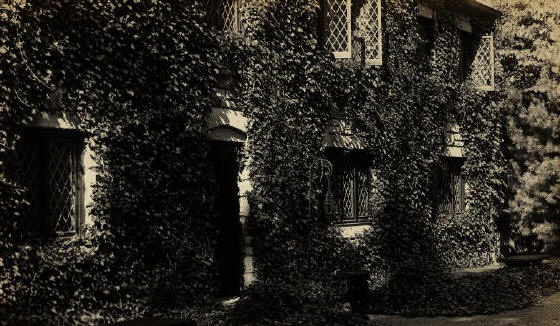
The ivy-covered exterior of Twigmore taken some years after it was first built.
From the Kate Matthews Collection, Photographic Archives,
Ekstrom Library, University of Louisville
During her 16-year absence from Pewee Valley, Lillian left Twigmore in the care of her nephew, Matthews Fletcher, who lived in a Victorian cottage on the Peace Lane property adjoining hers. That property, shown as Spring Glen on the Little Colonel game board, was used by Annie Fellows Johnston in “Two Little Knights of Kentucky” as the model for the Johann Heinrich’s cottage.
Charles W. Brackett’s death in 1969 made national news and was noted in “Time” magazine as well as on the AP wire:
“Time” Magazine
Died. Charles Brackett, 76, screenwriter and producer, whose 30-year Hollywood stint brought him three Oscars and a six-year term (1949-55) as president of the Academy of Motion Picture Arts and Sciences; of a stroke; in Bel Air, Calif. Brackett began writing short stories for the Saturday Evening Post, soon switched to The New Yorker as drama critic. Next stop was Hollywood in 1932, where he and Billy Wilder collaborated on 15 pictures, including Academy Award winners The Lost Weekend (1945) and Sunset Boulevard (1950). Brackett’s final Oscar was for his Titanic (1953) screenplay, which captured all the heroism and much of the horror of the world’s greatest maritime disaster.
“Associated Press” wire service story
Charles Brackett Dies at 77; Made Oscar-Winning Movies
‘Sunset Boulevard,’ ‘The Lost Weekend,’ and ‘Titanic’ Among His Successes
HOLLYWOOD March 9— Charles Brackett, the writer and producer who teamed up with Billy Wilder to win Oscars for the movies “Sunset Boulevard” and “The Lost Weekend,” and won one on his own for “Titanic,” died today at his Bel-Air home. He was 77 years old.
Mr. Brackett, who headed the Academy of Motion Pictures Arts and Sciences from 1949-1953, had been in failing health for more than two years.
Mr. Brackett’s first wife, the former Elizabeth Fletcher, whom he married in 1919, died in 1948. In 1953, he married her sister, Buff, who survives, as does a daughter, Mrs. C.J. Moore, Jr.
Tolerant, Witty, Skilled
Mr. Brackett combined the philosophical tolerance of the legal mind with the acerbic wit of the critic and the skill of the writer to become one of Hollywood’s elder statesmen and most successful figures.
His films were often challenging departures from tried-and-true formulas into new and controversial subject matter.
Mr. Brackett shunned a tendency of much of the movie industry to often run a successful idea into the ground.
“Mostly people want a change from what was done before,” he said. “But in finding what they want next, you have to fly by the seat of your pants.”
Urbane, thorough and affable, Mr. Brackett was once described by a writer in The New York Times as a “man who reads current biographies and peanut gallery literati during his rest periods, is generally accredited born with a scholar’s zeal for tracking down basic human foibles.”
Man of Several Careers
The world of the movies was dear to Mr. Brackett. He once wrote: “It is pleasant to learn that, to any member of the lay public who knows you have some connection to the industry, you are touched with glory. You have penetrated mysteries beyond the dreams of little men.”
His own penetrations were not premeditated; Hollywood was his third or fourth career.
Charles Brackett was born in Saratoga Springs, N.Y., and graduated in 1915 from Williams College, where he was editor of the literary monthly and a member of the dramatic club. His father, Edgar Truman Brackett, a lawyer, served in the New York Legislature.
His studies at Harvard Law School were interrupted by World War I. Mr. Crackett served as vice consul at St. Nazalre, France, and was later commissioned a second lieutenant in the American Expeditionary Force.
His war experiences prompted him to write a short story, which was bought by a national magazine. He returned to law school, but found time from his studies to write a novel, “The Counsel of the Ungodly.” The Saturday Evening Post published it serially in 1920. That same year, he graduated from law school, and for the next six years, practiced law with his father’s firm and wrote magazine articles and stories.
A second novel, “Weekend,” in 1925, attracted the attention of Harold Ross, the editor of The New Yorker magazine, who gave Mr. Brackett a job the following year as drama critic. Mr. Brackett stayed at the magazine until 1929, when he resigned to devote more time to his own writing. In 1926, he had published “The Last Infirmary” and in 1929, “American Colony.”
His first flirtation with Hollywood came with a six-week contract to Paramount in 1932. His first screen credit came in 1937 with “Picadilly Jim,” which he wrote in collaboration with Edwin H. Knopf.
Mr. Brackett was assigned by Manny Wolf, a Paramount story editor, to work with Billy Wilder, a young, Viennese writer, on “Bluebeard’s Eighth Wife,” which became a success in 1938.
The next year, Mr. Brackett and Mr. Wilder came out with “Midnight” and “Ninotchka.” The latter, starring Greta Garbo and Melvyn Douglas in a sprightly satire on Soviet ways, was critically acclaimed.
The two continued to collaborate. They did “Arise My Love” (1940), “Hold Back the Dawn” (1941), “Ball of Fire” (1942), and “The Mayor and the Minor” (1942).
“Five Graves to Cairo” was the first film they did together as a writer-producer-director team. They jointly wrote it, Mr. Wilder directed and Mr. Brackett produced.
In 1945, they brought out “The Lost Weekend,” based on Charles Jackson’s best-selling story of a dipsomaniac. The film won the Academy of Motion Pictures Arts and Sciences Oscar for the best picture and best screenplay.
Team “Happiest Couple”
Mr. Wilder described himself and Mr. Brackett as the “happiest couple in Hollywood.” As partners, they termed themselves “executive writers” and jointly commanded weekly salaries of several thousand dollars.
The teammates were opposites in nature and spirit. Mr. Wilder was intellectually scattering ideas at will; Mr. Brackett was philosophic and restrained. Mr. Wilder loved exercise; Mr. Brackett admitted abhorring sunshine, vitamins and fresh air and only enjoying “shuffling the cards for the only game worthy of a man’s dignity, cribbage.”
Mr. Brackett produced “The Uninvited” in 1944 and “To Each His Own” in 1948 independently of Mr. Wilder, but joined with him on “The Emperor Waltz,” a musical; “A Foreign Affair,” a satirical comedy; and “Sunset Boulevard” in 1950. The last, starring Gloria Swanson, William Holden and Eric von Stroheim, won a best screenplay Oscar for the team.
In 1950, Mr. Brackett ended his association with Paramount Pictures and became a producer with Twentieth Century-Fox. In 1953, he won an Oscar for his screenplay for “Titanic.” Some of his other films included “Ten North Frederick,” “Journey to the Center of the Earth,” “D-Day, the Sixth of June,” “The Virgin Queen,” “Niagara,” “The Remarkable Mr. Pennypacker,” “State Fair,” and “Wayward Bus.”
Mr. Brackett served as president of the Screenwriters Guild in 1938-39 and from 1949-1955 was president of the American Academy of Motion Picture Arts and Sciences. He had been a member of the executive board of the Screen Producers Guild and the board of the Motion Picture Relief Fund.
Additional information: in 1926, Brackett’s novel “That Last Infirmity” was published with another in 1929, “American Colony” and finally “Entirely Surrounded” in 1934. He had two daughters; Alexandra C. (Mrs. James Larmore) and Elizabeth F. (Mrs. Clifford J. Moore).
Some additional information about Charles Brackett taken from an online profile:
Family
Daughter: Alexandra Brackett Larmore (survived him)
Son-in-law: James Larmore (worked as Brackett’s assistant)
Wife: Buff Brackett (sister of his first wife; married c. 1949 – note: they actually married in 1953)
Wife: Elizabeth Brackett (first wife; died in 1948)
(Missing from this list is his daughter, Elizabeth F. Moore, who preceded him in death)
Honors
Writers Guild of America Founders Award 1967
Honorary Oscar 1957
Golden Globe Award Best Motion Picture- Musical/Comedy “The King and I” 1956
Writers Guild of America Laurel Award for Achievement 1956
Oscar Best Story and Screenplay “Titanic” 1953
Golden Globe Award Best Motion Picture- Drama “Sunset Boulevard” 1950
National Board of Review Best American Film “Sunset Boulevard” 1950
Oscar Best Screenplay “Sunset Boulevard” 1950
Writers Guild of America Award Best-Written American Drama “Sunset Boulevard” 1950
Golden Globe Award Best Motion Picture “The Lost Weekend” 1945
New York Film Critics Circle Award Best Picture “The Lost Weekend” 1945
Oscar Best Screenplay “The Lost Weekend” 1945
For a complete filmography of Charles Brackett, see the Internet Movie Database
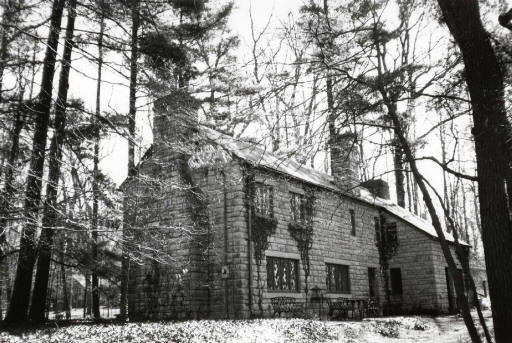
The rear of the house from Peace Lane. Photo, c. 1990, from “Historic Pewee Valley.”
After her husband’s death, Lillian returned to Twigmore and lived there until her death on May 5, 1984. During her final years in Pewee Valley, she championed Kate Matthews’ photography and gave an address to the Oldham County Historical Society on 1974 about the importance of her aunt’s work.
The Bracketts (Charles, Elizabeth and Lillian) are buried at Greenridge Cemetery in Saratoga Springs, New York. His parents were Father: Edgar Truman Brackett b: 30 JUL 1853 in Wilton, Saratoga, New York; Mother: Mary Emma Corliss b: 17 FEB 1857 in New York.
Lillian Fletcher Brackett’s will is on file at the Oldham County Court House:
LAST WILL AND TESTAMENT
OF
LILLIAN FLETCHER BRACKETT
I, LILLIAN FLETCHER BRACKETT, a resident of Oldham County, Kentucky, do make this my Last Will and Testament, hereby revoking all former Wills made by me.
ITEM I I direct that of my just debts, funeral expenses and costs of administration of my estate be paid first.
ITEM II (a) I give and bequeath all the Brackett Family furniture and household effects to ELIZABETH FLETCHER BRACKETT MOORE to be distributed by her to family members as she deems proper. For purposes of identification of such property, I have prepared and signed prior to the signing of this Will, a list of all such furniture and household effects, which list will be found attached to this will and which list shall be conclusive as to the property disposed of by this paragraph.
(b) I give and bequeath all of my other tangible personal property, including, but without being limited to jewelry, household furniture and furnishings, in accordance with a memorandum entirely in my handwriting, which will be found in this Will. Any tangible personal property not disposed of by memorandum, or all such tangible personal property if no such memorandum be found, I give and bequeath equally to MATTHEWS FLETCHER, MARY ELIZABETH BENHAM, LILLIAN F. KLEIN, CHARLES BARROWS FLETCHER and PAUL MARTIN FLETCHER.
ITEM III (a) I direct that my Co-Executors hereinafter named shall reduce all the rest, residue and remainder of my estate, real and personal, to cash. In disposing of my residence at 121 Peace Lane, Pewee Valley, Kentucky, I direct that my Co-Executors shall have the property appraised by a competent appraiser familiar with the area and that before offering such property for sale to any other purchaser, publicly or privately, that the property be first offered at the appraised value to my nephew, MATTHEWS FLETCHER. If MATTHEW FLETCHER does not exercise the option to purchase at the appraised value, such property shall be offered to my grandnephew, PAUL MARTIN FLETCHER at the appraised value and if he does not exercise the option, then to ELIZABETH FLETCHER BRACKETT MOORE at the appraised value, and if she shall not exercise the option, such property shall then be offered to my nephew, CHARLES BARROWS FLETCHER at the appraised value. If CHARLES BARROWS FLETCHER does not exercise the option to purchase at the appraised value, such property shall then be offered to my niece, MARY ELIZABETH BENHAM at the appraised value, and if she shall not exercise the option, then to my niece LILLIAN F. KLEIN at the appraised value. If none of such persons exercise the option to purchase at the appraised value, then my Co-Executors are authorized and directed to sell such property, either publicly or privately, as my Co-Executors deem proper, and whether or not the actual sales price is greater or lesser than the appraised value.
(b) After my residuary estate has been reduced to cash as directed in subparagraph (a) of this Item, I give and bequeath all such property absolutely and in fee simple as follows:
(b-1) Seventy-Five per cent (75%) thereof to my nephew, MATTHEWS FLETCHER, if living, and if not living, to his wife, LILLIAN B. FLETCHER, and if she is not living, such Seventy-Five per cent (75%) to be divided equally among those persons listed in subparagraphs (b-2) through (b-5) hereof.
(b-2) Five per cent (5%) thereof to my grandniece, MARJORIE FLETCHER THOMPSON.
(b-3) Five per cent (5%) thereof to my niece, MARY ELIZABETH BENHAM.
(b-4) Five per cent (5%) thereof to my niece, LILLIAN F. KLEIN.
(b-5) Five per cent (5%) thereof to my nephew, CHARLES BARROWS FLETCHER
(b-6) Five per cent (5%) thereof to my grandnephew, PAUL MARTIN FLETCHER
(c) If any persons listed in subparagraphs (b-2) through (b-6) shall predecease me, than such share shall pass to their issue, in fee and per stirpes.
ITEM IV I nominate and appoint MATTHEWS FLETCHER and THE LOUISVILLE TRUST COMPANY, of Louisville, Kentucky, as Co-Executors of this Will, with full power and authority to compromise or otherwise settle or adjust any and all claims, charges, debts or demands against or in favor of my estate, as fully as I could do if living, and with full power, without order of Court, to sell and convey any of my property for the purpose of administration, division or distribution in carrying out the terms of this Will. I request that MATTHEWS FLETCHER qualify for such Co-Executor without surety on his official bond.
IN TESTIMONY WHEREOF, I do subscribe my name to this Will, consisting of this page and two (2) preceding pages, typewritten on one side only of each page, and for the purpose of identification, I have also subscribed my name at the bottom of each of said preceding pages, all on this 7th day of August, 1978.
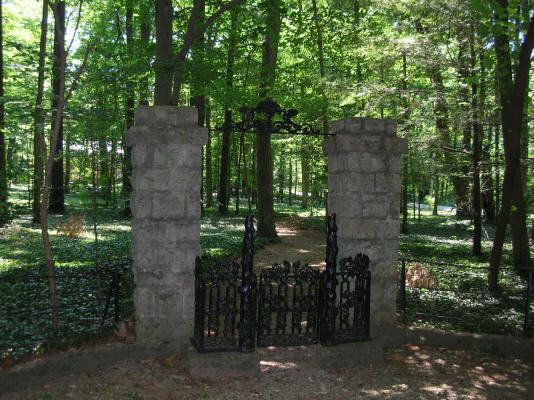
Pewee Valley Town Historian Gin Herdt Chaudoin and her sister, Cis Herdt Marker, can recall the year
Twigmore’s distinctive wrought iron gate, shown above, was stolen as a Halloween prank.
Thanks to John and Anne Kyser for providing information about the house and supplying the photos of Twigmore under construction; to Nancy Donner for her assistance with procuring Lillian Fletcher Brackett’s will; to Delinda S. Buie at Univeristy of Louisville’s Ekstrom Library for the copy of Lillian Fletecher Brackett’s 1974 address on Kate Matthews; and to Suzanne L. Perry for information on the Bracketts’ burial site and Charles Brackett’s parents.
Page by Donna Russell
